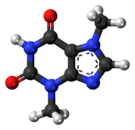테오브로민
테오브로민(theobromine, 이전 명칭: 잔테오스(xantheose)[1])은 쓴 맛이 나는 카카오 식물의 알칼로이드이며 화학식은 C7H8N4O2이다.[1] 초콜릿 외에도 차 식물잎, 콜라 나무 열매 등을 포함한 수많은 다른 음식에서 볼 수 있다. 잔틴 알칼로이드로 분류되며,[2] 이 중 다른 것들로는 테오필린과 카페인을 포함한다.[1] 카페인이 기타 메틸기를 갖고 있다는 점에서 화합물의 차이가 있다.

| |

| |
| 체계적 명칭 (IUPAC 명명법) | |
|---|---|
| 3,7-dimethyl-1H-purine-2,6-dione | |
| 식별 정보 | |
| CAS 등록번호 | 83-67-0 |
| ATC 코드 | C03BD01 R03DA07 |
| PubChem | 5429 |
| 드러그뱅크 | DB01412 |
| ChemSpider | 5236 |
| 화학적 성질 | |
| 화학식 | C7H8N4O2 |
| 분자량 | 180.164 g/mol |
| SMILES | eMolecules & PubChem |
| 유의어 | xantheose diurobromine 3,7-dimethylxanthine |
| 약동학 정보 | |
| 생체적합성 | ? |
| 동등생물의약품 | ? |
| 약물 대사 | Hepatic en:demethylation and oxidation |
| 생물학적 반감기 | 7.1±0.7 hours |
| 배출 | Renal (10% unchanged, rest as metabolites) |
| 처방 주의사항 | |
| 임부투여안전성 | ? |
| 법적 상태 |
|
| 투여 방법 | Oral |
"테오브로민"이라는 이름에도 불구하고 이 화합물은 브로민이 포함되어 있지 않으며, 테오브로민(theobromine)은 카카오나무의 속의 이름인 테오브로마속에서 비롯된 것이다.(그 자체는 그리스어 낱말 theos(신들)과 broma(음식)으로 구성되며 이는 신들의 음식을 뜻한다)[3]) -ine으로 끝나는 것은 알칼로이드와 다른 염기 질소 함유 화합물에 적용된다.[4]
테오브로민은 약간의 수용성이 있으며(330 mg/L[5]), 결정화되어 있고, 쓴 맛이 나는 가루이다. 테오브로민은 흰 색이거나 색이 없지만 상용 견본은 노란색을 띈다.[6] 인간 신경계의 카페인의 것과 비슷하거나 그보다 조금 더 낮은 효력이 있으며 더 낮은 동족체(homologue)로 만들어준다. 테오브로민은 파라잔틴 외에도 테오필린의 이성질체이다. 테오브로민은 디메틸 잔틴으로 분류된다.[7]
테오브로민은 1841년[8] 러시아의 화학자 알렉산드르 보스크레센스키에 의해 카카오 콩에서 처음 발견되었다.[9] 잔틴으로부터의 테오브로민의 합성은 1882년 헤르만 에밀 피셔에 의해 처음 보고되었다.[10][11][12]
그리고,이 성분은 사람에겐 폐평활근을 이완시켜주지만 동물에겐 근육경련, 호흡곤란, 설사를 일으킨다.
같이 보기
편집각주
편집- ↑ 가 나 다 Malisoff, William Marias (1943). 《Dictionary of Bio-Chemistry and Related Subjects》. Philosophical Library. 311, 530, 573쪽. ASIN B0006AQ0NU.
- ↑ Baer, Donald M.; Elsie M. Pinkston (1997). 《Environment and Behavior》. Westview Press. 200쪽. ISBN 978-0813331591.
- ↑ Bennett, Alan Weinberg; Bonnie K. Bealer (2002). 《The World of Caffeine: The Science and Culture of the World's Most Popular Drug》. en:Routledge, New York. ISBN 978-0-415-92723-9. (note: the book incorrectly states that the name "theobroma" is derived from Latin)
- ↑ 〈-ine〉. 《The American Heritage Dictionary of the English Language, Fourth Edition》. en:Houghton Mifflin Company. 2004. ISBN 978-0-395-71146-0.
- ↑ 테오브로민 - ChemIDplus 데이터베이스
- ↑ “theobromine”. Dictionary.com. 2007년 2월 22일에 확인함. For convenience, the direct source of the three definitions used has been cited.
- ↑ “Theobromine”. On-Line Medical Dictionary. 2007년 2월 23일에 확인함.
- ↑ von Bibra, Ernst; Ott, Jonathan (1995). 《Plant Intoxicants: A Classic Text on the Use of Mind-Altering Plants》. Inner Traditions / Bear & Co. 67–쪽. ISBN 978-0-89281-498-5.
- ↑ Woskresensky A (1842). “Über das Theobromin”. 《Liebigs Annalen der Chemie und Pharmacie》 41: 125–127. doi:10.1002/jlac.18420410117.
- ↑ Thorpe, Thomas Edward (1902). 《Essays in Historical Chemistry》. The MacMillan Company.
- ↑ Fischer, Emil (1882). “Umwandlung des Xanthin in Theobromin und Caffein”. 《Berichte der Deutschen Chemischen Gesellschaft》 15 (1): 453–456. doi:10.1002/cber.18820150194.
- ↑ Fischer, Emil (1882). “Über Caffein, Theobromin, Xanthin und Guanin”. 《Justus Liebigs Annalen der Chemie》 215 (3): 253–320. doi:10.1002/jlac.18822150302.
외부 링크
편집- 위키미디어 공용에 테오브로민 관련 미디어 분류가 있습니다.